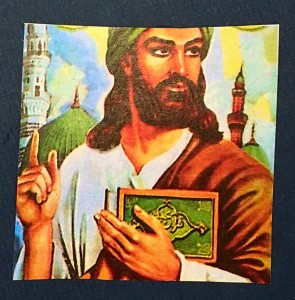Center versus Periphery Practices

Center versus Periphery Collage

“Center” Practices

Drinking the Qur’an; a periphery practice

Depiction of the Prophet; a periphery practice

Ta’ziyeh; a periphery practice

A Chinese-Style Mosque
In this blog post, I will discuss the theme of center versus periphery practices in Islam. Section leader, Ceyhun, defined periphery practices as those that were observed by only a subset of the Muslim population. Center practices, on the other hand, are closer to the core of Islam and are therefore practiced by a larger number of Muslims. I placed examples of “center” practices in the yellow circle. The Qur’an assumes its rightful place in the center, as it is the keystone of the religion. It is surrounded by a lantern, symbolizing the idea that Allah is the source of illumination, the shahada, a map symbolizing pilgrimage to Mecca, accompanied by a picture of the ka’ba, an image symbolizing the zakat, the numbers 1-5, representing the 5 times a day one must pray to Mecca, and examples of classic arabesque. These practices and images are at the core of the faith and are recognized by the vast majority of Muslims.
However, it is not uncommon for those who identify with communities of interpretation closer to the “center” to cast a wary eye on peripheral practices, as some see them as impurities in the faith. This is seen in the El-Tom’s “Drinking the Qur’an:The Meaning of Quranic Verses in Berti Erasure.” El- Tom writes with scientific authority, as he assesses the practice of erasure, or drinking of Quranic verses in order to aid the drinker in an array of different circumstances, in African-Islamic cultures (El-Tom, 1985, p. 417). El-Tom defines erasure as a periphery practice at the outset, saying, “The drinking of Koranic verses seems to be widespread only on the periphery of the Islamic world,” (1985, p. 415). El-Tom’s distinction between what he refers to as “classical” (1985, p. 428) and what is periphery carries throughout the work. He says that the meaning of Qur’an verses is “assigned and imposed” (El-Tom, 1985, p.428) by the Berti, further casting doubt on the practice. These statements raise a host of questions. Who has the authority to determine what is peripheral and what is not? In other words, why is El-Tom able to make this judgement about another community of interpretation? Does this type of assessment place some communities above others in terms of validity? My opinion is that if a practice allows individuals to feel closer to God, its legitimacy may be defended.
This theme can be connected to ideas seen later in the course. Three more such ideas are represented on the poster. The Chinese-style mosque shows the blending of Chinese-style architecture with Islam. The Ta’ziyeh is a passion play depicting the death of Hussein that is observed ardently, but only in Iran. A small number of communities of interpretation allow for the depiction of religious figures, such as the Prophet himself, while most consider that idolatry.